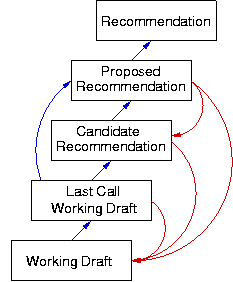W3C: World Wide Web Consortium

How to protect your innovation thru Web Standards ?
Daniel Dardailler, W3C Director for Europe.
Why W3C?
Mission: Interoperability by Consensus
- Growth of web protocols
- Threat of fragmentation
- Need for new features, while keep universality
- Need for neutral party
What is W3C?
- ~500 members
- ~70 staff.
- Tim Berners-Lee Director (Inventor of the Web)
- MIT/INRIA/Keio, + Offices (Europe, Africa, Asia, etc)
- 5 domains: Architecture, Document Formats, Interaction, Technology
& Society, Accessibility
See our home page at http://www.w3.org
HTTP, HTML/XML and URL
HTTP
GET /index.html HTTP/1.1
Accept-Charset: iso-8859-5, unicode-1-1
...
HTML/XML
<title> Web History <\title>
<p> A paragraph of text <\p>
URL
http://www.w3.org/People/danield
news:comp.windows.x
mailto:danield@w3.org
What does W3C do?
- Provide a neutral forum for meeting
- Technically expert specification editing
- Achieving consensus
- Working Drafts and Recommendations, not standards
- Reference code where appropriate
How does W3C work?
- Identify need for a new area of standardization: workshops,
submissions
- Activity proposal submitted to membership
- Creation of working groups
- Development of specifications, tools, support materials
- Process:

W3C Web Technologies and Activities
- Hypertext Protocols (HTTP1.1) - with IETF: stable
- Extensible Markup Language: XML - Core, Schema, Query, Link, XSLT,
etc
- Web Services: just started (SOAP, WSDL, etc)
- Adressing (URL, URI, etc)
- Open source code: Jigsaw Java HTTP server
- Hypertext (XHTML, HTML4.0)
- Style Sheets (CSS2, XSL)
- Graphics (PNG, SVG)
- Document Object Model (DOM)
- Synchronized Multimedia: SMIL
- Math Markup (MathML)
- Voice Browser/Mobile Access/Television and the Web
- Internationalization (I18N)
- Open source code: Amaya browser/editor
- Metadata/Content Selection (RDF, Semantic Web)
- Privacy (P3P)
- Digital Signature (XSIG)
- Accessibility Guidelines for Web Content, Browser, AuthoringTools
- Accessibility Education & Outreach
- Quality Assurance: across the board
Semantic Web and Web Services
- Same goal: make the Web more intelligent
- Add richness to the data
- SW: use metadata like RDF that says things about data
- WS: provide a programmatic interface (API) to the Web data
- Machine-readable Web: allow for programming the
Web
Benefits of using Web Standards
- Guarantee of vendor independence (both software/hardware)
- Guarantee of interoperability (internally and externally)
- Guarantee of universality (language, culture, disability)
- Guarantee of evolvability
- Guarantee of durability
Benefits of W3C membership
- A seat at the negotiation table
- An understanding of other member's needs
- Advance information (6 months)
- A neutral place to meet
Public Resources
